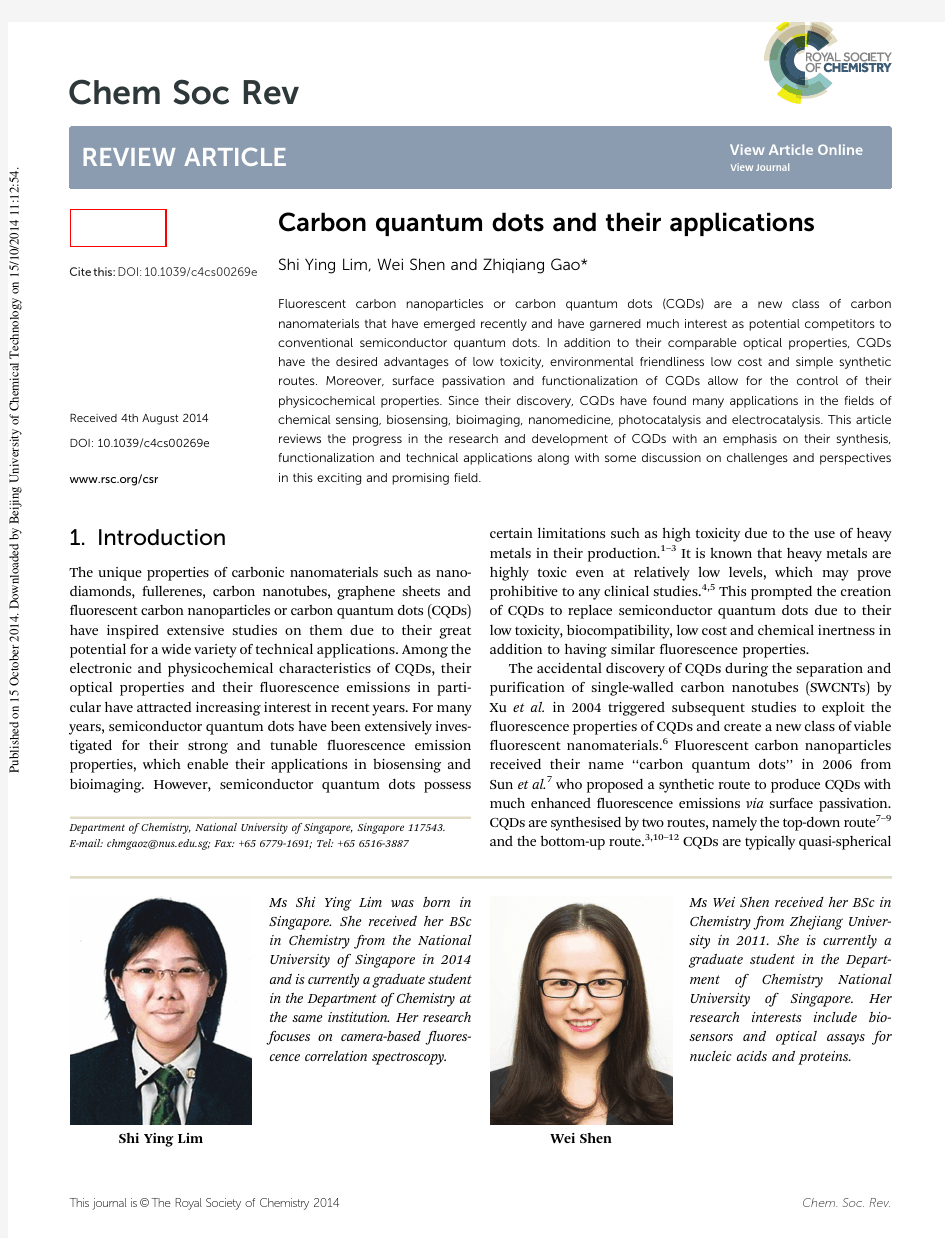碳量子点及其应用综述

相关主题
- 1、下载文档前请自行甄别文档内容的完整性,平台不提供额外的编辑、内容补充、找答案等附加服务。
- 2、"仅部分预览"的文档,不可在线预览部分如存在完整性等问题,可反馈申请退款(可完整预览的文档不适用该条件!)。
- 3、如文档侵犯您的权益,请联系客服反馈,我们会尽快为您处理(人工客服工作时间:9:00-18:30)。
Review Article
View Article Online
Chem Soc Rev
Fig. 1 Chemical structure of CQDs. (Reproduced with permission from ref. 13.)
nanoparticles comprising amorphous to nanocrystalline cores with predominantly graphitic or turbostratic carbon (sp2 carbon) or graphene and graphene oxide sheets fused by diamond-like sp3 hybridised carbon insertions (Fig. 1).13–16 Oxidised CQDs contain considerable amounts of carboxyl moieties at their surface. Depending on the synthetic route, the oxygen content in the oxidised CQDs ranges from 5 to 50% (weight).14 As shown in Fig. 1, there are many carboxyl moieties on the CQD surface, which impart excellent water solubility and suitable chemically reactive groups for further functionalization and surface passivation with various organic, polymeric, inorganic or biological materials to CQDs. Upon surface passivation, the fluorescence properties of CQDs are enhanced. Surface functionalization also modifies their physical properties, like their solubility in aqueous and non-aqueous solvents.
Ms Shi Ying Lim was born in Singapore. She received her BSc in Chemistry from the National University of Singapore in 2014 and is currently a graduate student in the Department of Chemistry at the same institution. Her research focuses on camera-based fluorescence correlation spectroscopy.
Ms Wei Shen received her BSc in Chemistry from Zhejiang University in 2011. She is currently a graduate student in the Department of Chemistry National University of Singapore. Her research interests include biosensors and optical assays for nucleic acids and proteins.
Published on 15 October 2014. Downloaded by Beijing University of Chemical Technology on 15/10/2014 11:12:54.
Chem Soc Rev
REVIEW ARTICLE
Βιβλιοθήκη Baidu
View Article Online
Department of Chemistry, National University of Singapore, Singapore 117543. E-mail: chmgaoz@nus.edu.sg; Fax: +65 6779-1691; Tel: +65 6516-3887
certain limitations such as high toxicity due to the use of heavy metals in their production.1–3 It is known that heavy metals are highly toxic even at relatively low levels, which may prove prohibitive to any clinical studies.4,5 This prompted the creation of CQDs to replace semiconductor quantum dots due to their low toxicity, biocompatibility, low cost and chemical inertness in addition to having similar fluorescence properties.
View Journal
Carbon quantum dots and their applications
Cite this: DOI: 10.1039/c4cs00269e Shi Ying Lim, Wei Shen and Zhiqiang Gao*
Received 4th August 2014 DOI: 10.1039/c4cs00269e www.rsc.org/csr
The accidental discovery of CQDs during the separation and purification of single-walled carbon nanotubes (SWCNTs) by Xu et al. in 2004 triggered subsequent studies to exploit the fluorescence properties of CQDs and create a new class of viable fluorescent nanomaterials.6 Fluorescent carbon nanoparticles received their name ‘‘carbon quantum dots’’ in 2006 from Sun et al.7 who proposed a synthetic route to produce CQDs with much enhanced fluorescence emissions via surface passivation. CQDs are synthesised by two routes, namely the top-down route7–9 and the bottom-up route.3,10–12 CQDs are typically quasi-spherical
Shi Ying Lim
This journal is © The Royal Society of Chemistry 2014
Wei Shen
Chem. Soc. Rev.
Published on 15 October 2014. Downloaded by Beijing University of Chemical Technology on 15/10/2014 11:12:54.
1. Introduction
The unique properties of carbonic nanomaterials such as nanodiamonds, fullerenes, carbon nanotubes, graphene sheets and fluorescent carbon nanoparticles or carbon quantum dots (CQDs) have inspired extensive studies on them due to their great potential for a wide variety of technical applications. Among the electronic and physicochemical characteristics of CQDs, their optical properties and their fluorescence emissions in particular have attracted increasing interest in recent years. For many years, semiconductor quantum dots have been extensively investigated for their strong and tunable fluorescence emission properties, which enable their applications in biosensing and bioimaging. However, semiconductor quantum dots possess
Fluorescent carbon nanoparticles or carbon quantum dots (CQDs) are a new class of carbon nanomaterials that have emerged recently and have garnered much interest as potential competitors to conventional semiconductor quantum dots. In addition to their comparable optical properties, CQDs have the desired advantages of low toxicity, environmental friendliness low cost and simple synthetic routes. Moreover, surface passivation and functionalization of CQDs allow for the control of their physicochemical properties. Since their discovery, CQDs have found many applications in the fields of chemical sensing, biosensing, bioimaging, nanomedicine, photocatalysis and electrocatalysis. This article reviews the progress in the research and development of CQDs with an emphasis on their synthesis, functionalization and technical applications along with some discussion on challenges and perspectives in this exciting and promising field.
